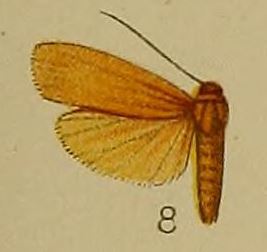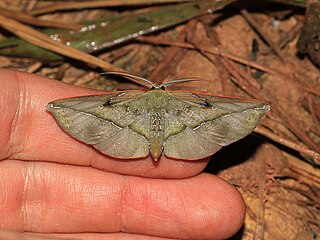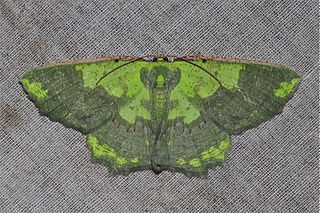
Brunia is a genus of tiger moths in the family Erebidae. The genus was described by Moore in 1878.
Mantala is a monotypic moth genus in the subfamily Arctiinae. Its single species, Mantala tineoides, is found on Borneo. Both the genus and the species were first described by Francis Walker in 1862. The habitat consists of lowland and lower montane forests.
Lygniodes schoenbergi is a moth of the family Erebidae. It is found on Borneo. The habitat mainly consists of lowland forests, particularly alluvial forests.

Brunia antica is a moth of the family Erebidae described by Francis Walker in 1854. It is found from the Indian subregion, Sri Lanka to China, the Ryukyu Islands, the Chagos Archipelago, the Nicobar Islands and Sundaland.
Abaciscus paucisignata is a species of moth belonging to the family Geometridae. It was described by Warren in 1899. It is known from Peninsular Malaysia and Borneo.

Omiza lycoraria is a geometer moth in subfamily Ennominae first described by Achille Guenée in 1857. It is found in Peninsular Malaysia, Borneo and Sumatra. The species is most common in lowland forests but may be found in lower and upper montane forests up to about 1800 m.

Scopula butleri is a moth of the family Geometridae. It was described by Prout in 1913. It is found in the north-eastern Himalaya, Sumatra, China, Japan and Borneo. The habitat consists of lowland forests and lower montane forests.
Scopula hyphenophora is a moth of the family Geometridae. It is found in India, Peninsular Malaysia and on Borneo and Bali. The habitat consists of lowland primary and secondary forests, alluvial forests and forests on limestone.
Scopula phallarcuata is a moth of the family Geometridae. It is found on Borneo. The habitat consists of lowland forests and lower montane forests on limestone. It has also been recorded from various softwood plantations in the lowlands of Sabah.
Scopula vacuata is a moth of the family Geometridae. It is found on Borneo. The habitat consists of lowland forests but it can occur as high as 1,000 metres in the lower montane forest zone. The species is often found in softwood plantations and secondary forests in lowland Sabah.
Micrulia medioplaga is a moth in the family Geometridae first described by Charles Swinhoe in 1902. It is found on Borneo, Bali, Sulawesi and Sri Lanka. The habitat mostly consists of lowland forests, but it has also been recorded in lower montane forests.
Brunia apicalis is a moth of the family Erebidae. It was described by Francis Walker in 1862. It is found on Borneo. The habitat consists of forests, ranging from lowlands to 1,200 meters.
Brunia badrana is a moth of the family Erebidae. It was described by Moore in 1859. It is found on Java and Bali.
Brunia sarawaca is a moth of the family Erebidae. It was described by Arthur Gardiner Butler in 1877. It is found on Borneo, Peninsular Malaysia, Java and the north-eastern Himalayas. The habitat consists of lowland forests.

Cyana conclusa is a moth of the subfamily Arctiinae. It was described by Francis Walker in 1862. It is found on Borneo and Sumatra. The habitat consists of lowland forest types, excluding heath forests.
Eilema fasciculosa is a moth of the subfamily Arctiinae. It is found on Borneo, Peninsular Malaysia and Bali. The habitat consists of lowland forests, particularly alluvial forests.

Hyposemansis singha is a species of moth in the family Erebidae first described by Achille Guenée in 1852. It is found in the Himalayas, Taiwan, Myanmar and on Borneo and Sumatra. The habitat consists of forests, ranging from the lowlands to elevations of about 1,760 meters, but is mostly found in lowland dipterocarp forests.
Teulisna chiloides is a moth in the family Erebidae. It was described by Francis Walker in 1862. It is found on Peninsular Malaysia, Sumatra, Borneo, Sulawesi and Sumbawa. It has also been recorded from Queensland, Australia. The habitat consists of lowland dipterocarp forests, alluvial forests and lower montane forests.

Hyposidra aquilaria is a geometer moth in the Ennominae subfamily. It is found in Northwestern Himalaya, Western, Southern and Eastern China, Peninsular Malaysia, Sumatra, and Borneo. It is a rare species of lowland forests.

Agathia obsoleta is a species of moth in the family Geometridae first described by William Warren in 1897. It is found in Java, Sumatra, Borneo and the Philippines. A. obsoleta is a rare species of lowland forests, including heath forest.






